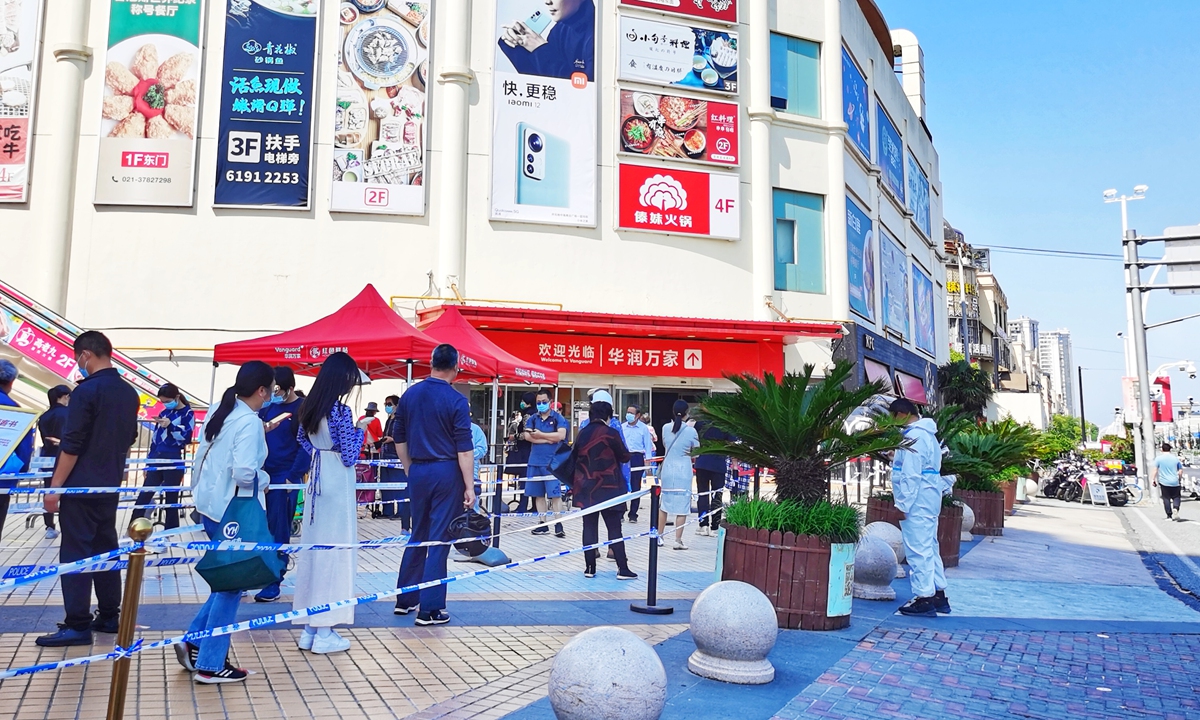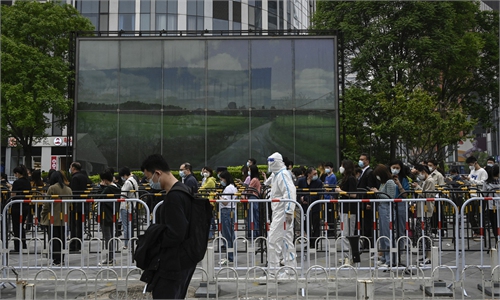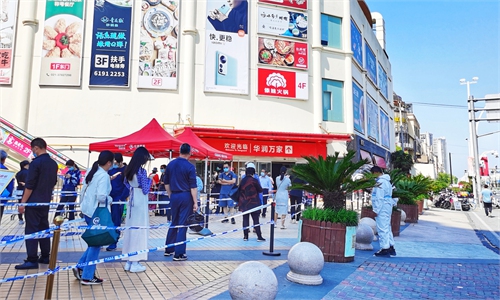
Shanghai Photo: VCG
As Shanghai reported 215 local confirmed COVID-19 cases and 3,760 silent carriers on Saturday, the 10th consecutive day of declines, China's top epidemiologist Zhang Wenhong, among a number of other scientists, said in an article in The Lancet on Sunday that the city is "seeing the light at the end of the tunnel in this round of the epidemic."Some experts agreed with Zhang's judgment, but also noted that more attention should be paid to how the relaxation of control measures will be implemented and what prevention there will be against rebounds, since people's immunity has been weakened as a result of the long-term lockdown.
In the country's most arduous fight against the epidemic since the Wuhan outbreak in 2020, the city with a population of 25 million is at a crucial stage when, like rowing a boat upstream, it "would fall back if it stops moving forward," local health authorities said on Sunday, after the city reported over 600,000 COVID-19 infections in the past two months.
They have vowed to block any transmission at the community level as soon as possible, while adhering to a scientific approach that avoids over-simplification or one-size-fits-all moves.
Li Qiang, Secretary of the Shanghai Municipal Committee of the Communist Party of China (CPC), stressed on Saturday the need to unswervingly stick to the dynamic zero-COVID policy with focuses on reducing new cases and preventing rebounds, after a top leadership meeting warned against attempts to distort, question or dismiss the dynamic zero-COVID policy, as well as any slackening in the control efforts.
With areas being lifted from lockdown and businesses resuming operation and production in a steady manner, Shanghai, once shadowed by an unrelenting Omicron wave, has seen hints of hope in recent days.
On Saturday, the first batch of medical staff coming to aid the massive nucleic acid testing process in Shanghai from the neighboring Jiangsu and Anhui provinces completed their work and headed home. They came to the city in late March when the epidemic was at its worst situation.
Medical workers from Jiangsu, Anhui and Zhejiang reached nearly 300,000 people.
A makeshift hospital in Shanghai's Chongming Industrial Park announced it would close on Saturday after having completed its tasks. It was used for 13 days and received 1,501 COVID-19 patients, the majority of whom recovered and were discharged from the hospital.
In the article published in The Lancet titled "Shanghai's life-saving efforts against the current Omicron wave of the COVID-19 pandemic," Zhang Wenhong said that Shanghai people welcome their coming emergence from this round of the epidemic, and the city's strict epidemic control measures bought more time for vaccination and bringing down elderly fatalities.
Yang Zhanqiu, a professor in the pathogen biology department at Wuhan University, agreed with Zhang's judgment, as supported by the consecutive decreases in infection numbers and virus clearance in some parts of the city. The large number of patients being discharged from makeshift hospitals and the closure of these hospitals also suggest that the situation is improving.
However, he believed that these positive developments are coming later than previously expected, and he urged relevant parties to step up efforts.
While more regions in the city are welcoming a relaxation of prevention measures, experts warned that more attention should be paid to how the relaxation is implemented and to prevention against rebounds.
A Beijing-based immunologist told the Global Times on Sunday on condition of anonymity that since Shanghai has a relatively large area of infections, with a few thousand people still being infected every day, approaches to ease the controls should be carefully considered. What's more, the long-term lockdown could lead to weakened immunity in the human body due to lack of nutrition and exercise, so possible epidemic rebounds should be watched for.
To accelerate the screening of new risks at the community level, Shanghai has carried out nucleic acid tests on 63 million people and antigen tests on 126 million people from May 1 to Saturday, officials said at a press briefing on Sunday.
The nucleic acid and antigen combination tests will continue to be rolled out in locked-down, controlled and precaution zones, adopting different frequencies of testing based on the epidemic situation in each zone. City service provider personnel such as couriers and volunteers will have to take one nucleic acid test and two antigen tests each day with an interval of eight hours.
The Sunday press conference also shed light on the genetic sequencing of various COVID-19 samples detected in the city, which showed that the recent epidemic was mainly caused by Omicron mutations BA.2 and BA.2.2, and no new variant with stronger transmission ability was found.
A model developed by Yao Maosheng, a professor at the College of Environmental Sciences and Engineering at Peking University, showed that new infections will drop below 1,000 around May 19. By the end of May, the current infection wave in Shanghai is likely to be contained, and the city will gradually lift the lockdowns by then.
Yang suggested that another two weeks would be sufficient to effectively curb the current wave in Shanghai, as the incubation period of Omicron is relatively short, generally being two to three days.


